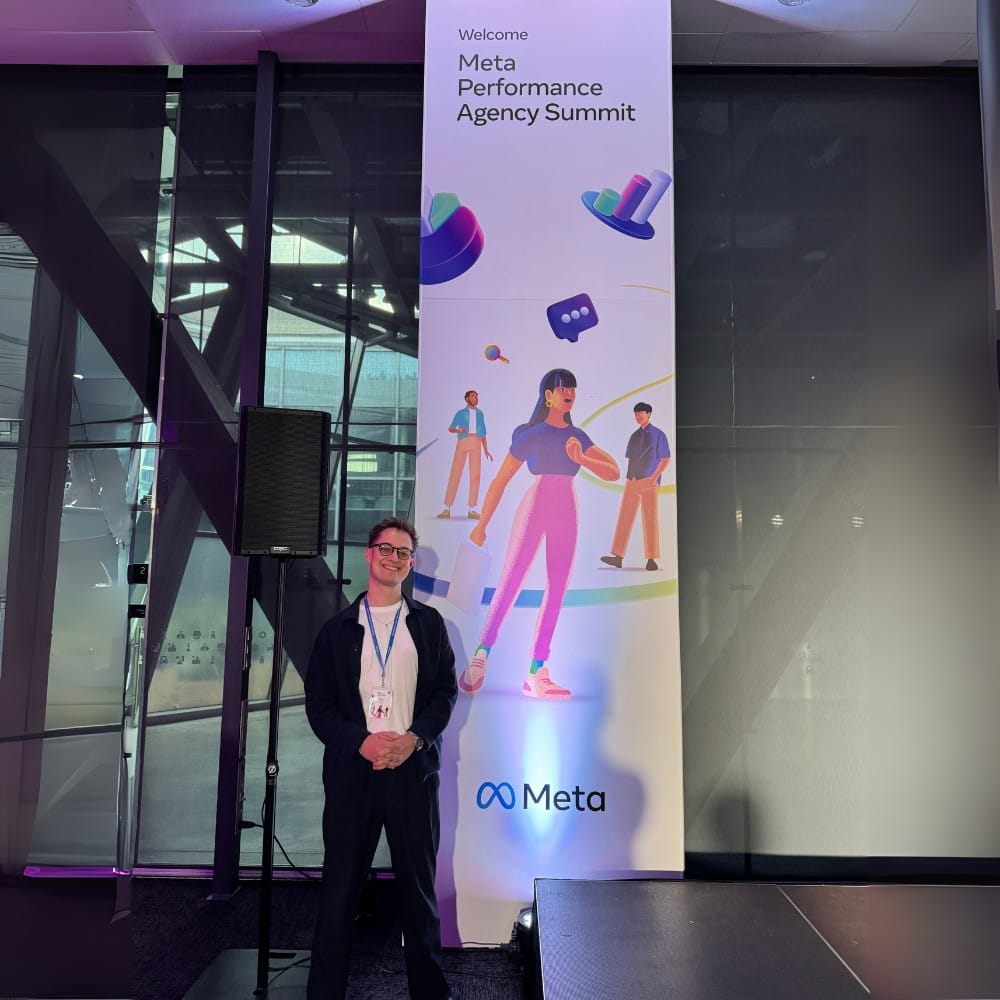I spent two days at Meta’s closed-door Agency Performance Summit.
An invitation-only event for 200 of EMEA’s top advertisers from agencies.
Over 12 keynote speakers, Q&As, and strategy deep-dives over two days.
As one of the attendees, I frantically took notes on everything (I have 15 pages of raw notes - absolutely insane).
They (Meta & the speakers) were sharing strategies, insights, and guidelines you can't find online anywhere else.
It all comes down to seven key themes. These are the lessons top advertisers (and Meta’s own experts) are laser-focused on right now.
Spoiler:
There are no magic tricks or hidden hacks here.
Real growth requires hard work and working with the algorithm while playing by Meta's rules
This is how you win, and here's what they taught us about the game.
Rigorous measurement, insane amounts of creative, intelligent use of AI, full-funnel thinking, quality data, and creative tactics like Reels and influencers.
But what does that mean specifically?
Here are my notes.
Incrementality and True Measurement
One theme came up again and again: incrementality.
This is figuring out what extra results your ads drive versus what you’d get without advertising.
In other words, which sales came because of your ads, and which would have happened anyway.
This isn’t an academic exercise; it’s become mission-critical for marketers who want real ROI.
As one Meta speaker put it, “Incrementality is so important - understanding what are the sales driven by your ads and what would you have made anyway.”
In practice, this means moving beyond last-click attribution and measuring the true lift your campaigns deliver.

One of the speakers, Dr. Daniel Knapp (Chief Economist at IAB Europe) hammered this point with a CFO-friendly perspective.
He explained that CMOs today are expected to “speak the CFO’s language,” linking ad spend directly to top-line or bottom-line impact. Clicks and impressions don’t pay the bills; sales, revenue, and profit do.
The summit talks urged us to prove our value: if you spent €100k on ads, how much incremental revenue did that drive after accounting for organic sales? If you can’t answer that, you're in trouble.
So I guess you're asking yourself:
How do you actually measure incrementality?
The consensus from Meta was to embrace experimental tools and robust analytics.
Meta’s team encouraged running regular lift tests (e.g., Facebook Conversion Lift studies or holdout tests) to isolate how many conversions your ads truly caused.
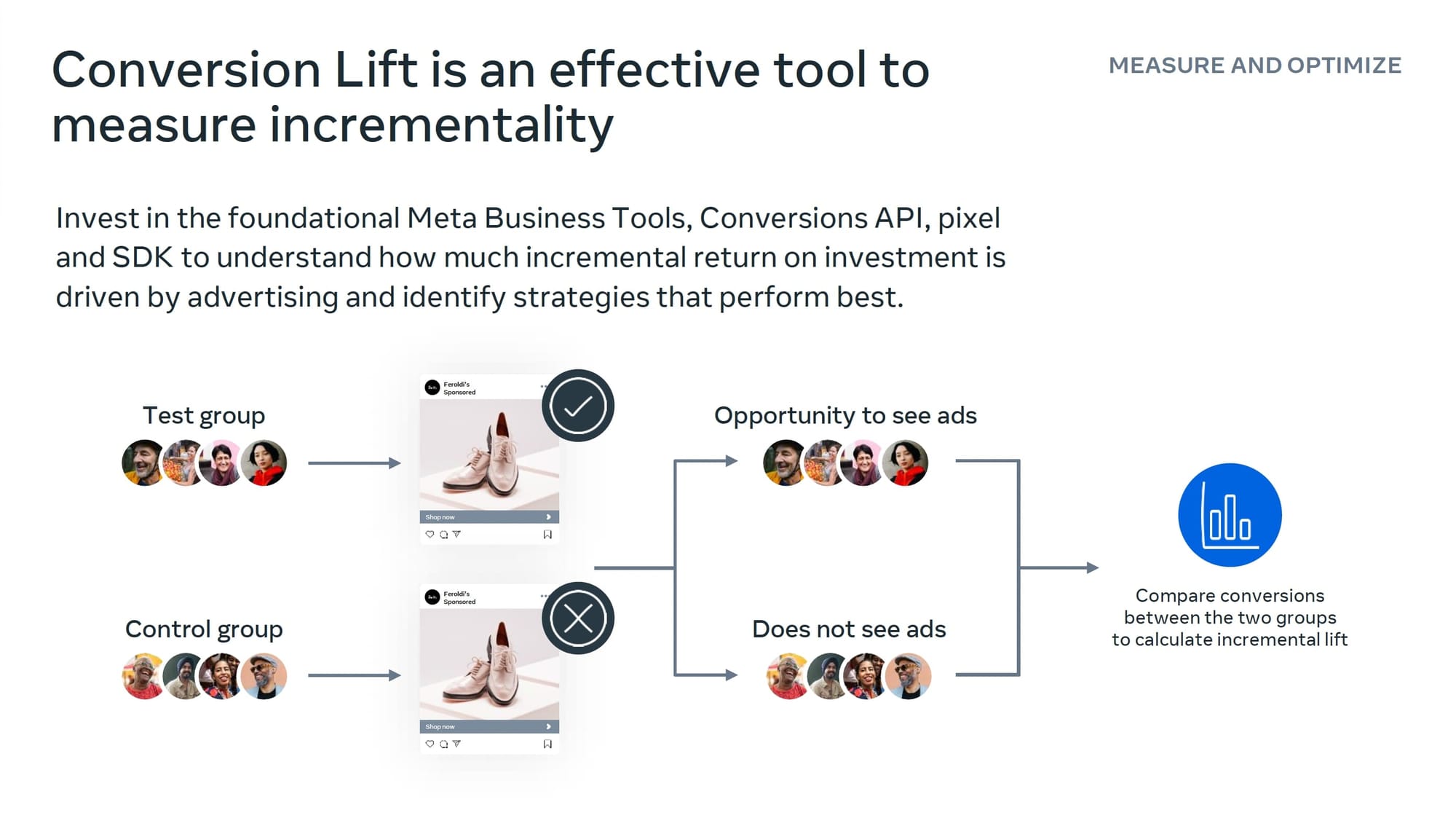
Another approach discussed was media mix modeling (MMM).
Yes, the old-school econometric models are making a comeback to estimate incremental sales across channels. The key is to test and learn: deliberately pause ads for a small control group or region, or use Meta’s built-in lift test tool, and measure the difference. If you find that a campaign isn’t actually driving new sales (ouch!), you can reallocate budget to what actually moves the needle.
Incrementality isn't just about patting yourself on the back it often reveals which tactics are truly profitable. For example, you might discover your retargeting ads mostly just capture people who were buying anyway, while your prospecting ads drive new customers.
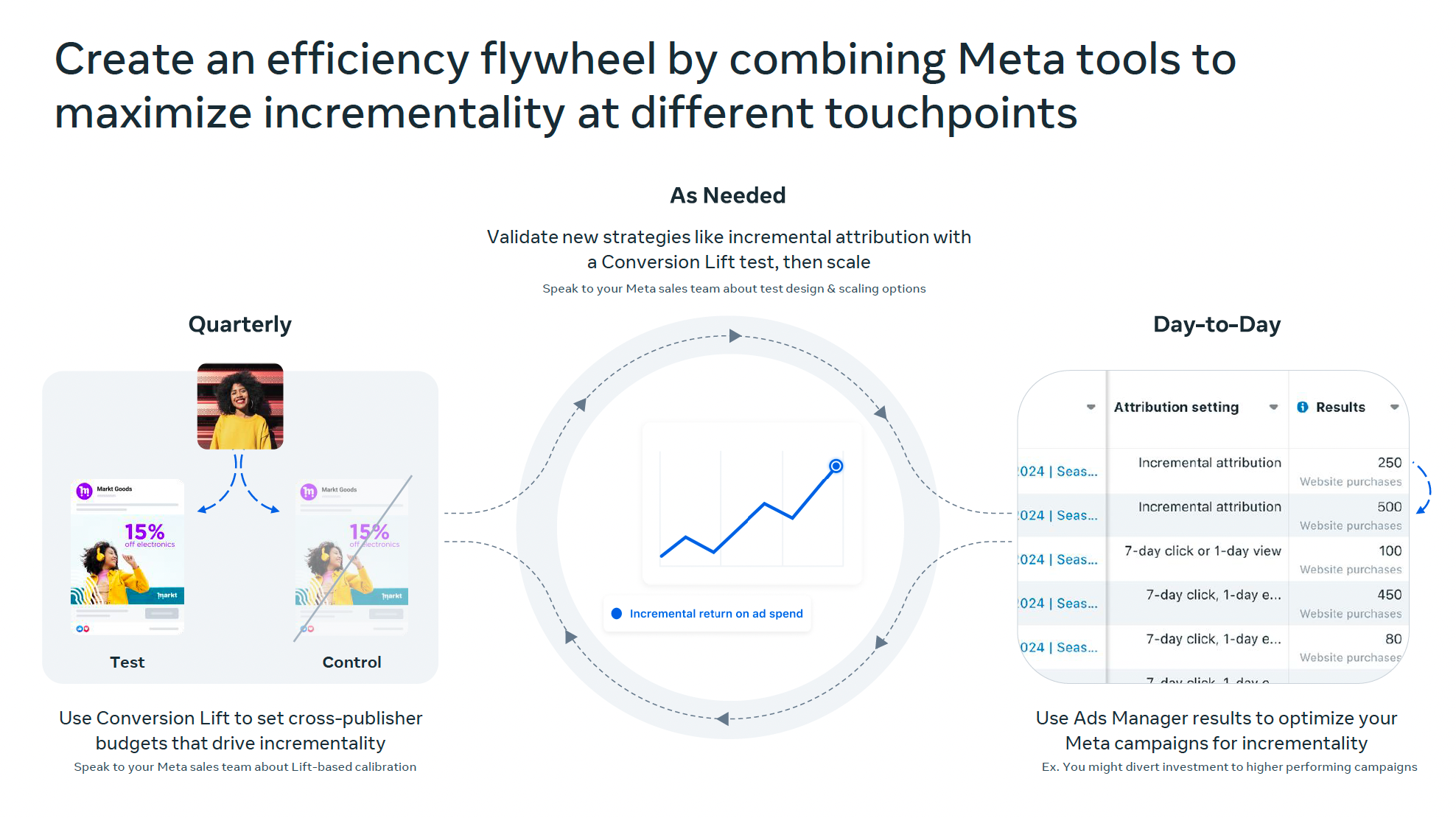
Armed with that evidence, you shift spend toward prospecting. The top marketers now talk about "outcome-based marketing" optimizing for actual business outcomes like incremental revenue or customer lifetime value, not proxy metrics.
It’s a mindset shift from:
“How cheap can I get a click?” to
“How much profit am I generating per euro, net of what would’ve happened regardless?”
Targeting Through Creative + Diversity
If there's one practical takeaway every speaker agreed on, it’s this:
Most advertisers need to produce way more creative.
Creative diversity and volume came up in multiple sessions.
Meta’s team recommended having around 15–20 active ads per ad set as a baseline, and noted that many top advertisers are now using AI to generate hundreds (some thousands!) of variations.
Why?
Because audiences get tired fast.
Ad fatigue is real.
Performance can drop sharply after a person sees the same ad a few times.
The only remedy is to keep refreshing your creatives.
I’ll admit, hearing that “20 creatives is a useful threshold” made me glance at my own ad sets (where I have 5-6 ads running at a time).
The summit made it clear that under-delivering on creative is leaving money on the table.
More variations give Meta’s algorithm more to work with and reduce the risk of burning out your audience on one message.
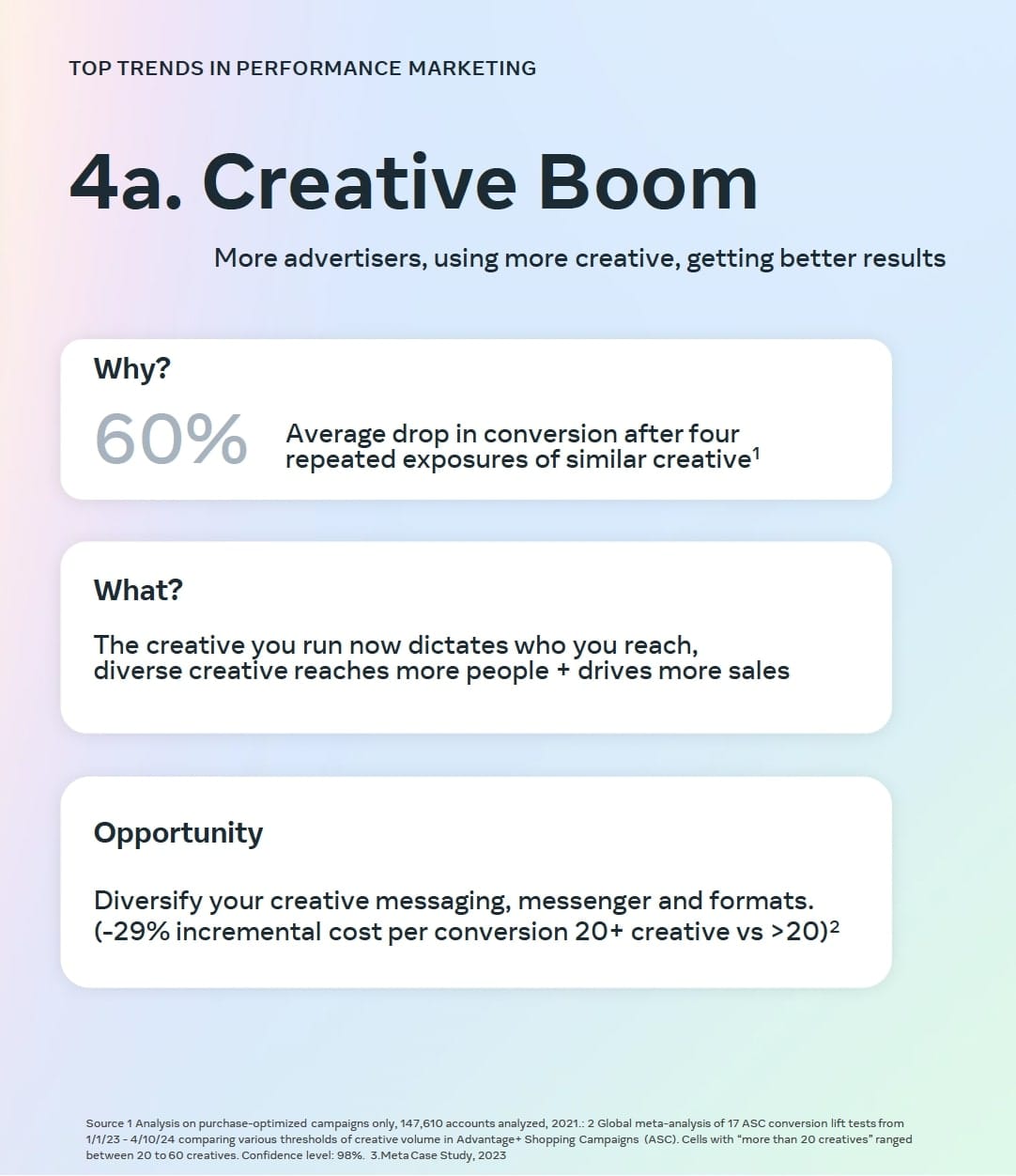
One of the Meta speakers even mentioned ad performance can plummet after just a few exposures of the same creative.
The solution: constant creative refresh.
Monitor frequency and click-through rate (CTR) on your ads. If frequency is climbing and CTR is falling, that ad is fatigued. Pause it and swap in fresh creative.
Better yet, set a cadence (say, bi-weekly) to review performance and proactively rotate creatives before they tank.
It's a never-ending cycle: test, identify winners, scale, then replace when performance softens.
Meta’s Dynamic Creative and Advantage+ Creative tools can automatically mix and match images, text, and CTAs to find top combos. This can effectively generate dozens of variants for you.
But even with automation, you need a pipeline of new assets. Consider creating multiple versions of each concept (with different headlines, visuals, and formats).
Aim to hedge your bets - don’t put all your spend behind one or two ads.
As the summit speakers stressed, even a “great” ad will wear out quickly, so always have backups ready.
One speaker gave a memorable quote:
“Show your product, show it as often as you can… show it from different perspectives… this will give the holistic view.”
In other words, don't be shy about volume.
Show your offer from every angle, literally and figuratively.
For example, if you sell a gadget, make one ad with a flashy product demo, another with a user testimonial, another as a carousel of use-cases, etc.
Variety is the name of the game.
When you find a winning ad, "abuse it," but not for too long.
Have the next variation ready to keep momentum.
This approach of high creative volume was repeatedly cited as a key practice of top-performing brands.
AI and Automation
We've entered the algorithmic era of marketing.
Algorithms are now doing the heavy lifting in ad targeting, bidding, and optimization.
But the big question at the summit was: What's the role of humans when so much is automated?
The answer: our role is still huge, just different.
Meta's stance is that AI should be seen as an enabler, not a replacement.
One Meta presenter put it plainly: "At Meta, we firmly believe that no one's job will be replaced by AI. It will be the superpower that lets us test and learn at unprecedented scale."
In other words, AI can crunch data and optimize faster than any human. But it needs to be pointed in the right direction by smart marketers.
What's working with AI now?
A lot.
Meta's Advantage+ products (Advantage+ creative, placements, Shopping campaigns) are automating what used to be manual.
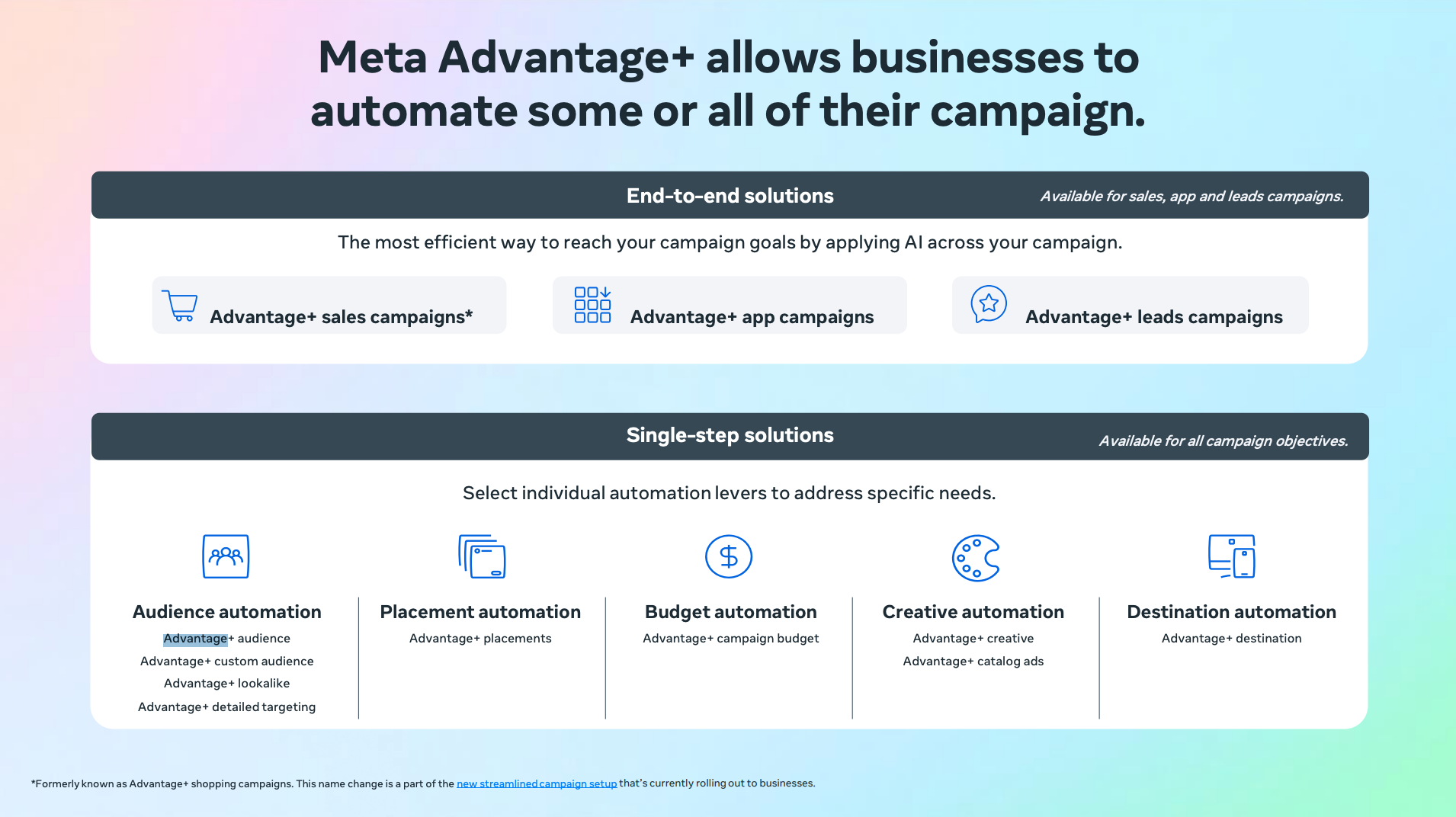
They dynamically serve the best creative, allocate budget across audiences, and find new customer pockets.
Many advertisers are seeing strong results with these, especially when they feed them enough quality data.
But AI is only as good as the input you give it.
You can't "set and forget."
The best advertisers guide the algorithms by giving them the best data and creative elements to work with.
If you feed Meta's AI weak creatives and sparse pixel data, results will disappoint.
The goal is human + machine, not human vs. machine. You supply strategic direction and high-quality ingredients, and let the AI do the tactical optimization.
Guiding AI also means checking its work.
Some top agencies override automated recommendations when their data suggests a better alternative, then compare results.
The lesson: don't be afraid to challenge the algorithm. Treat it as a very smart intern rather than an omniscient boss.
Do leverage AI for finding optimal placements, bids, and creative combos.
Do use new AI-driven features and test them rigorously.
Don't abdicate strategy. You still set the objectives, define success, and decide what inputs the machine gets.
Don't trust blindly, test proactively.
The winners will be those who embrace automation and keep a critical, strategic eye on it.
Full-Funnel Strategies and Outcome-Driven Media
A big takeaway from the summit:
Performance marketing doesn't mean only bottom-funnel.
Many speakers argued that focusing solely on retargeting or last-click tactics is a dead end.
The best advertisers are taking a full-funnel approach.
From broad awareness down to conversion.
And they're obsessed with real business outcomes (not just cheap CPA or ROAS in-platform).
Daniel Knapp highlighted a rebound in brand and upper-funnel investment.
Even in uncertain economic times.
Why?
Because if you cut brand marketing and only chase immediate sales, you eventually run out of new customers.
Demand generation (creating interest via video, influencers, content) is just as crucial as demand capture (harvesting intent via search, retargeting).
Multiple case studies showed that layering top-of-funnel Reels ads and influencer content onto conversion campaigns can produce a big jump in ROI.
The message: funnel diversity = scalable growth.
Upper-funnel tactics feed your lower funnel with new people.
If you only run bottom-funnel ads, you're squeezing the same orange harder and harder until it runs dry.
Meta's guidance? Audit your campaigns for a healthy blend of upper, mid, and lower-funnel efforts.
Broad video ads for awareness. Retargeting for consideration. Urgency-based offers for conversion.
Missing any layer leaves your funnel leaking.
This ties back to outcome-driven media. Instead of measuring each channel in isolation, top marketers track business outcomes.
New customer acquisition. Revenue. Profit.
That means using tools like Value Optimization bidding.
Meta introduced us to their "dual source" optimization strategy. It's the best of both worlds (volume & value). You can see it here:
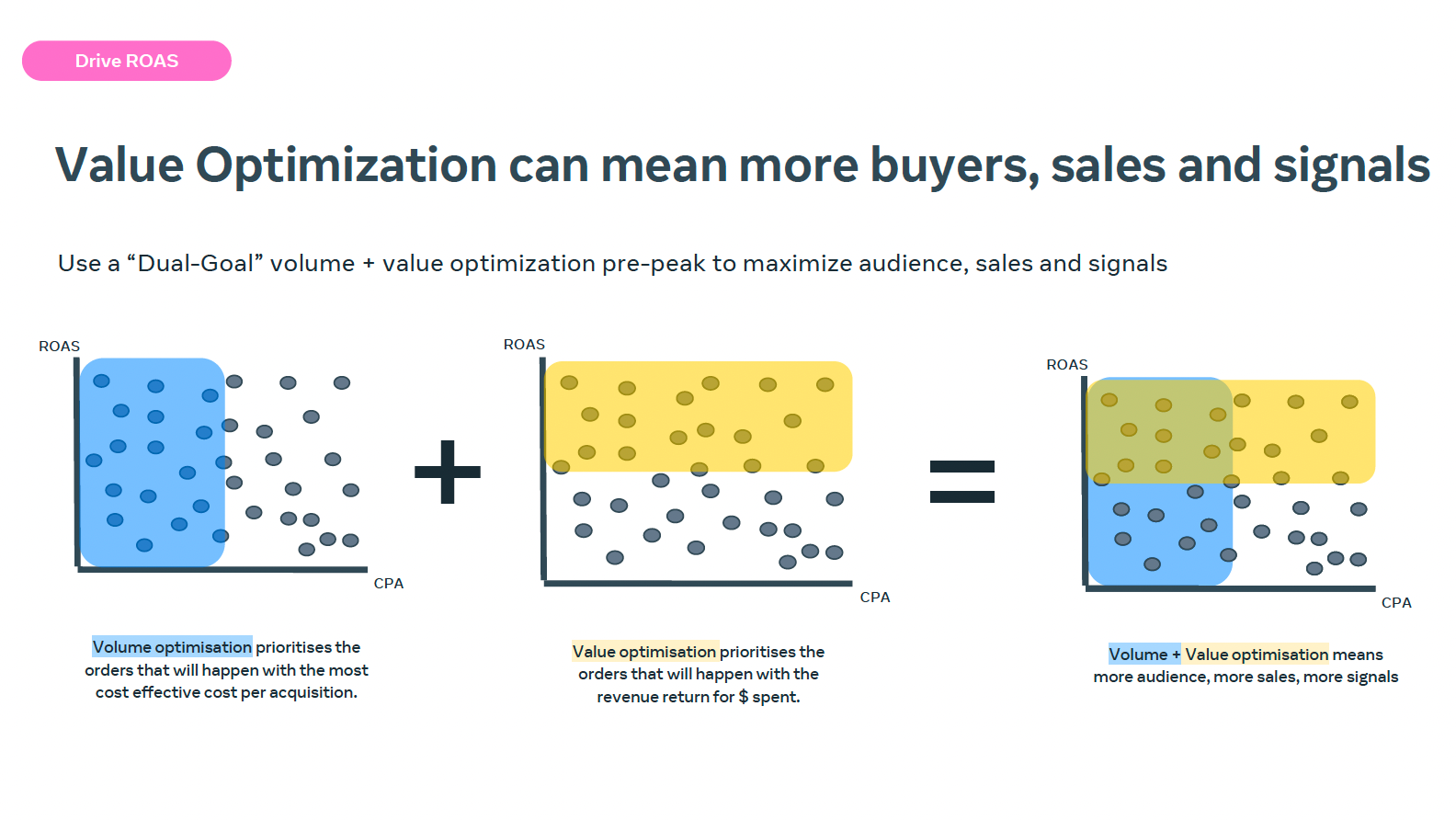
Tell Meta to "find buyers who will spend the most," not just any buyers.
Pass back purchase values or LTV data and let the algorithm prioritize quality over quantity.
First-Party Data and Signal Quality
Since iOS14 and GDPR, tracking has been tougher.
But the solution is clear: first-party data.
As one speaker put it, "Data is the new oil especially for Meta's AI."
The more high-quality data you feed in, the better the algorithm can optimize.
Hugo Stokalski from Meta stressed that advertisers who capture and share more first-party data will outperform.
That means sending every conversion event you can (purchases, leads, app events) with rich details like value, customer info (hashed), and offline conversions.
If you rely only on basic pixel data, you're limiting performance.
Key metric to watch: Event Match Quality (EMQ).
A score in Events Manager showing how well your customer data matches Meta's users.
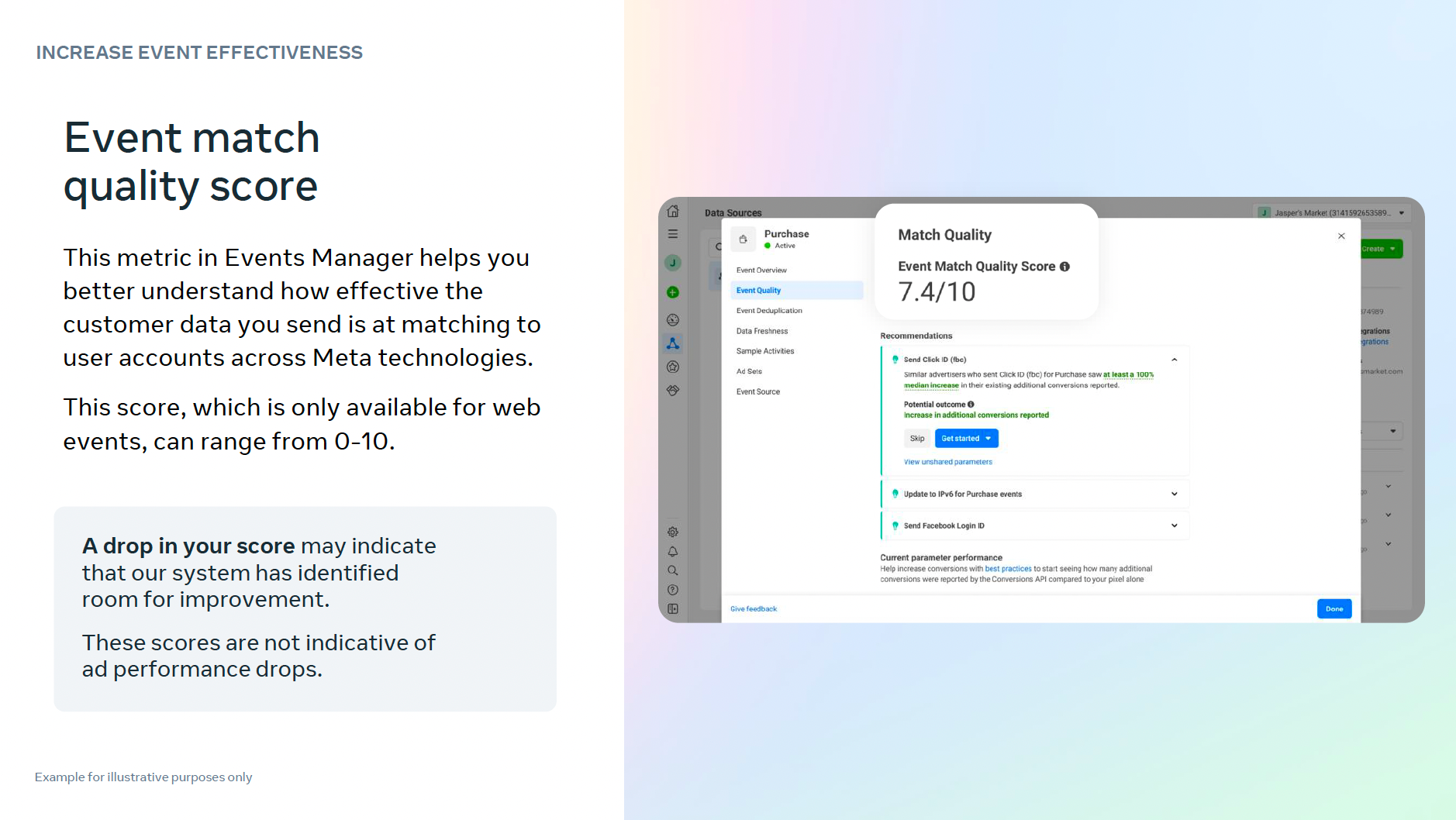
Higher EMQ means better attribution and optimization. Low EMQ? Fix missing parameters and improve match rates.
Best practices from the summit:
- Implement the Conversions API alongside your pixel, with proper deduplication.
- Pass back purchase details: product IDs, order value, coupon used, etc.
- Hash personal data before sending to Meta and ensure consent.
- Keep data clean and fresh, avoid duplicates.
Jessica Whitney called this "data readiness".
Auditing pixel and CAPI setups, passing profit or LTV data, and making sure the right values reach the platform.
Without these, you can't fully leverage Meta's optimization power.
Reels, Creator Partnerships, and Native Creative Tactics
Meta pushed hard on creative innovation, especially Reels and influencers.
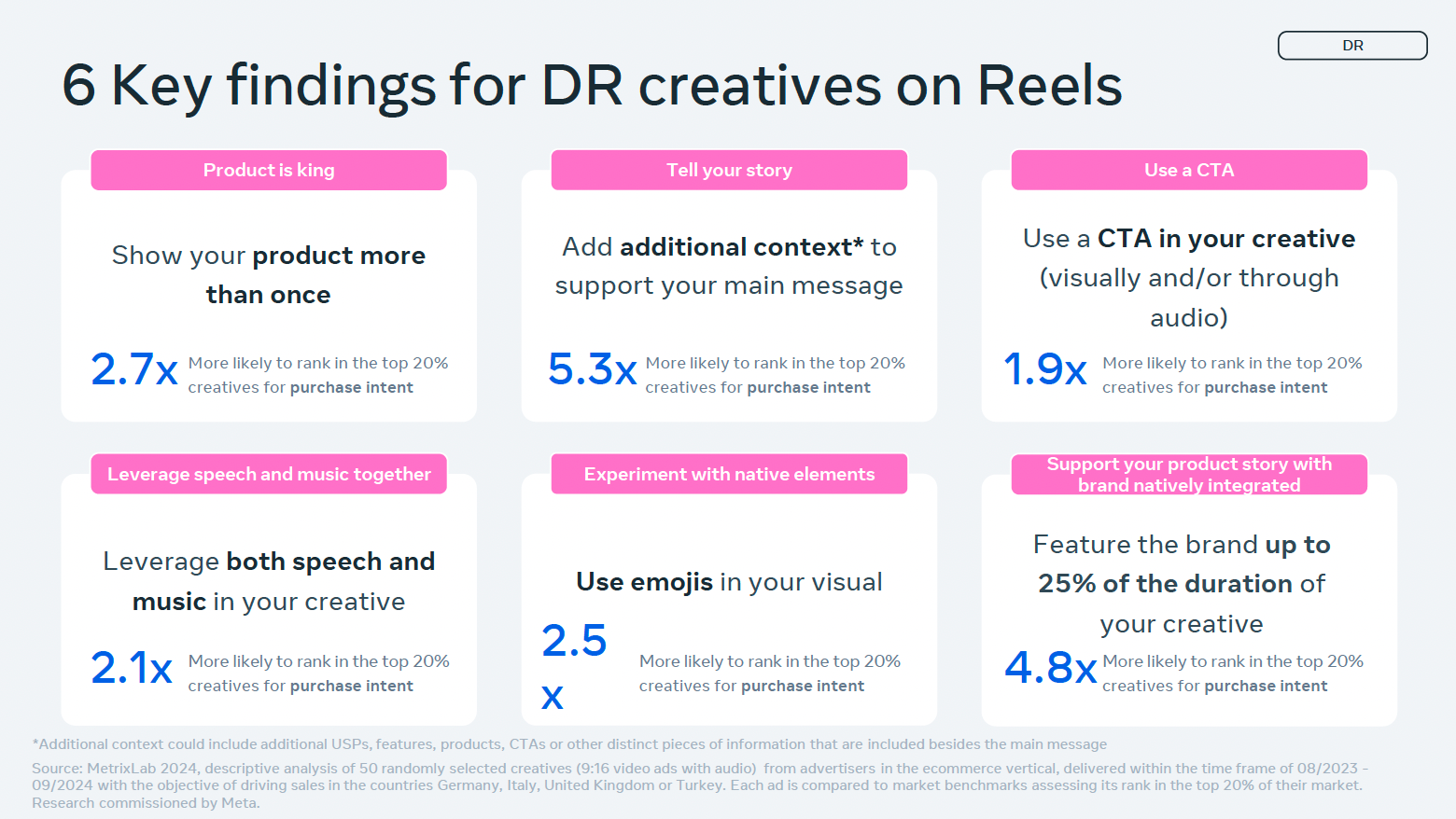
Native, platform-specific content is outperforming old-school glossy ads.
Reels = results.
Reels are not just for awareness. They can drive conversions when done right.
Use full-screen vertical video, add sound/music, keep text in safe zones, and show the product early and often.
Hook viewers in the first 1–2 seconds.
Creators boost trust.
Partnership Ads (running ads from a creator's handle) can slash acquisition costs.
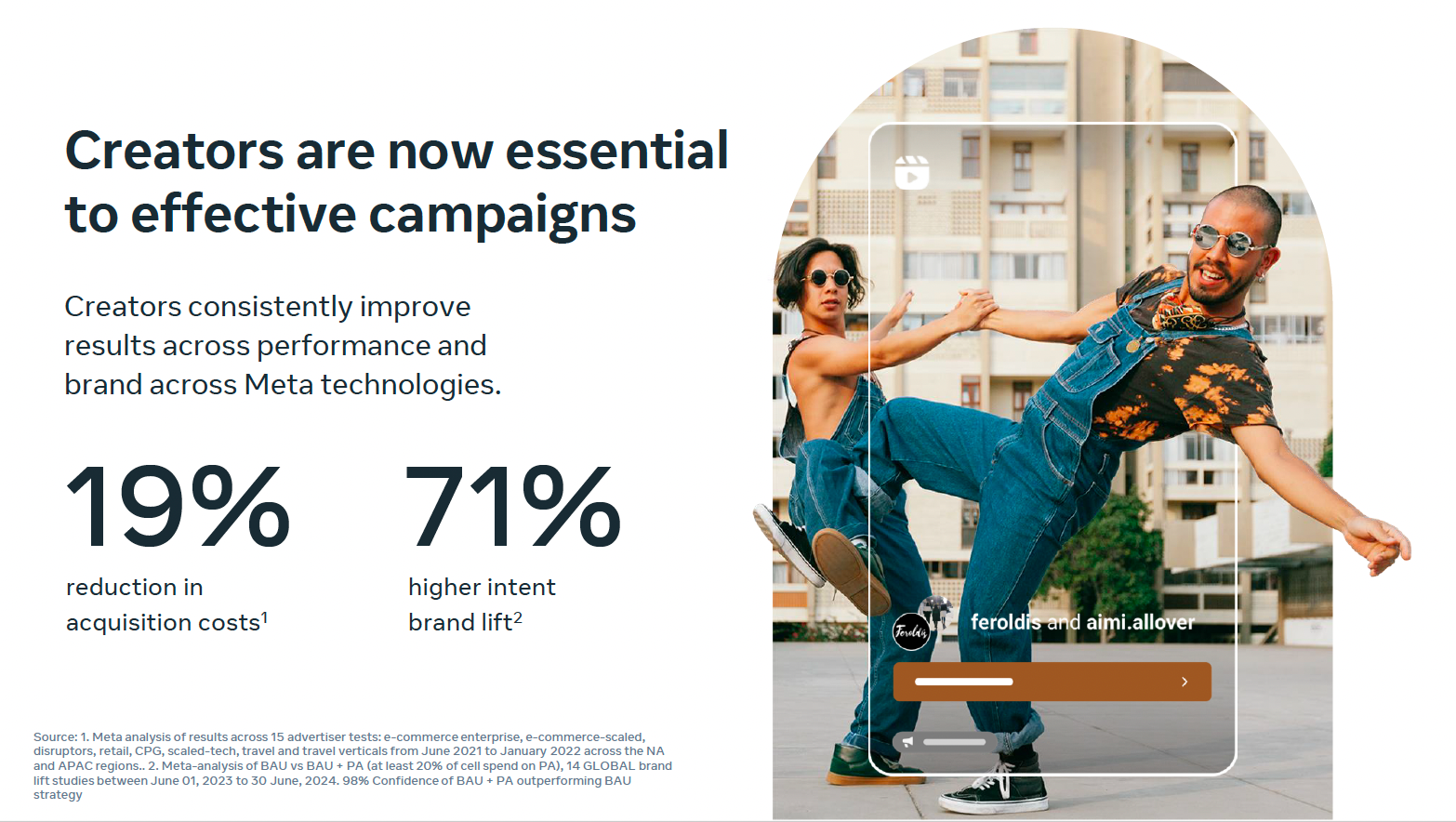
Some cases showed up to a 90% drop in CAC.
Ads from trusted creators feel like recommendations, so audiences convert more readily.
Example: NKM, a cosmetics brand, ran a full-funnel creative strategy with Reels and creators.
Awareness via creator Reels, mid-funnel testimonials, bottom-funnel offers.
Result: +19% conversion rate and a 50% ROAS lift.
Tactical tips:
- Design specifically for Reels. No lazy cropping.
- Work with micro-influencers for authentic content.
- Mix formats to prevent fatigue.
- Integrate creators into your funnel. Use them for hooks, testimonials, or retargeting content.
What Top Brands and Agencies Do Differently
Across sessions, the habits of top performers were clear:
- Incrementality mindset – running lift tests and holdouts to measure real impact, then reallocating budget accordingly.
- Better data feeding the algorithm – CAPI implemented, purchase values passed back, profit/LTV segments shared.
- High creative output – dozens of creatives ready, constant testing, not falling in love with one ad.
- Relentless experimentation – treating marketing like a lab, with hypotheses, controlled tests, and documented learnings.
- Full-funnel execution – balancing awareness, consideration, and conversion efforts for scalability.
- Proactive planning – early prep for peak seasons, contingency plans, daily monitoring and budget shifts.
It’s discipline and agility that separate the great from the average – not secret tools.
Final Thoughts
Overall, the summit was worth every minute of those two days.
I learned what separates top performers from everyone else. Not secret tactics. Just relentless execution of the fundamentals.
Meta didn't hold back. They laid out the entire playbook. Incrementality testing. Creative volume. First-party data. Full-funnel thinking. AI as an enabler. Reels and creator partnerships. And what top brands do differently.
The 7 lessons I've shared are a perfect starting point if you're looking to improve your Meta performance.
Take them and put them to work. Start with the one gap that's costing you the most right now.
If you have any questions regarding these strategies or want to discuss how to implement them for your business, feel free to reach out.


